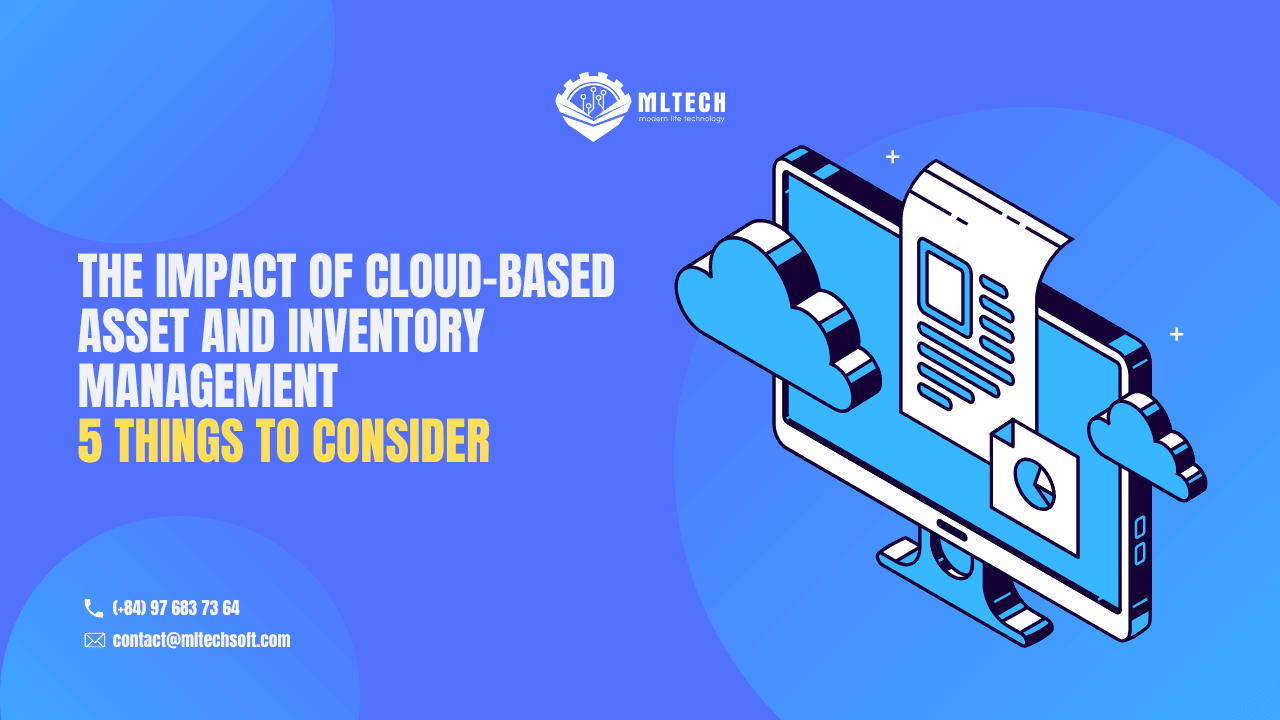Scroll down for more
The impact of cloud-based asset and inventory management: 5 things to consider

Wholesalers, manufacturers, and retailers who use cloud-based asset and inventory management need to pull themselves together and make sure they are using a scalable, strong, and tech-centered platform to track their assets and the flow of their inventory.
Organizations around the world could save trillions of dollars and use them to grow their businesses in other ways if they used cutting-edge technology to manage their assets and stock.
1. Why Cloud-Based Asset and Inventory Management: An overview
Cloud computing has been called a lifesaver by manufacturers, retailers, wholesalers, and any other business that needs to keep an eye on, track, and improve asset management and inventory tracking.
A SaaS-based (Software as a Service) platform for inventory and asset management in the cloud lets businesses track and monitor their assets, inventory status, and logistics in real-time and get accurate business insights to make smart business decisions.
Previously, businesses would do this by hand, using a pen and paper or spreadsheets. Also, when COVID hit a large number of people, businesses had to close, which caused a sudden loss of $4 trillion.
With this manual approach to inventory and asset management, businesses can't tell how their stock is doing, what raw materials they need to meet the needs of their vendors, or where their logistics are. Additionally, this results in disarray, confusion, and ultimately significant losses.
The cloud enables effective resolution of these issues, which is a game changer.

With cloud-based asset and inventory management, every SKU, item, and product, as well as its current location, can be kept in one place and tracked in real-time.
With a single tap on their cloud-based asset and inventory management platform, a business owner with multiple inventories all over the world can see which products need to be filled, which raw materials are needed, and what customers want.
Check out some of a typical cloud-based asset and inventory management system's most popular features:
Businesses can use cloud computing to find ways to save money, keep track of orders, communicate with vendors and suppliers, manage tickets, and protect themselves from loss and fraud, among other things.
2. The Effect of the Cloud on Asset and Inventory Management
When the cloud is used for asset and inventory management as a whole, operations are automatically optimized and managers are given the tools they need to make the right decisions at the right time.
Most importantly, put a stop to these unnecessary losses and waste.
Here are the major impacts of the cloud on asset management and inventory tracking that you shouldn’t ignore:
Unprecedented Automation
When it comes to managing assets and inventory, most of the important tasks and processes can be automated, making a system that is set up to get things done.
With a cloud-based inventory management system, you can fully automate a number of tasks, such as keeping track of products, routing them through multiple channels, and counting your inventory. Supply chain operations can be completely streamlined and automated with cloud computing.

Real-Time Business Intelligence
Now, this is one of the biggest advantages of cloud-based asset and inventory management operations. Businesses are now able to get real-time visibility of their inventory position and remove physical barriers such as time and location to accurately track their inventory. With real-time information about supply, demand, and inventory status, management knows exactly where their business is going and at what speed.
Seamless Integrations With 3rd Party Tools
Several third-party tools, such as order fulfillment apps and distribution software, CRM, sales and marketing tools, accounting software, and more, can be easily integrated with a cloud-based asset and inventory management system, expanding your operational capabilities.
Safety, Security, and Peace of Mind
Hackers can easily break into and change outdated or stand-alone systems. They can use this to steal valuable data from your inventory and hurt your business.
With cloud platforms such as AWS and Microsoft, there are several layers of data security and safety, which translates to peace of mind.

Advanced Analytics & Data Monitoring
Cloud-based systems for managing assets and inventory can also come with data analytics software and data monitoring tools, which, when combined with real-time insights, can give operations more control and transparency than ever before.
Analytics can be used to find demand and supply trends and insights. This gives you powerful business intelligence that can help you improve all parts of your operations.
3. How Do You Put A Cloud-Based Asset and Inventory Management Solution In Place?
We can make a powerful, scalable, and robust cloud-based asset and inventory management solution for your business that will:

Intuitive User-Interface for handling the operations smoothly, which is not only easy to navigate but also tweaked for maximum efficiency of your employees Exhaustive Usability to accommodate hundreds and thousands of SKUs, items, and products, based on a systematic and logical approach.
Powerful Programming so that your business operations are not hampered, and the inventory management team is able to utilize the platform for maximum benefits. Enhanced Cloud Capabilities, which include data backups, iron-clad data security, centralized data repository, universal data access, platform and location independent data access, role-based data access, and more.
Most importantly, a higher ROI is possible because the cloud reduces IT costs, eliminates all manual processes to free up resources, and allows you to focus on core business operations.
Conclusion
A well-planned migration to cloud-based systems should also consider the future.
What is the impact on the operating model, and does it need to change?
How can day-to-day active management and optimization drive ongoing value for the business?
Does the whole company have the skills and knowledge it needs to move quickly past the migration itself and start using the higher-level services that are available in the cloud?
Most important is the change toward the new business models that will be needed to be successful in the future. This means making a platform for innovation, allowing advanced digital technologies to work, and trying out new products and services.
Get our blog
Want the latest and greatest from our blog straight to your inbox? Chunk us your details and get a sweet weekly email.
Read more in our blog

Project Management
The Rise of AI-Generated Code: Opportunities & ChallengesExplore how AI-generated code is transforming programming with tools like GitHub Copilot and AlphaCode. Learn about the opportunities it offers—faster development, accessibility—and the challenges like security and ethics we must address.

Project Management
The Impact of Dynamic Pricing on Customer BehaviorExplore the impact of dynamic pricing on customer behavior and learn how to implement effective pricing strategies.

Project Management
Focus in Scrum: Keeping Your Team on TrackDiscover effective strategies to maintain focus within your Scrum team, overcome common challenges, and boost productivity.
MLTECH SOFT